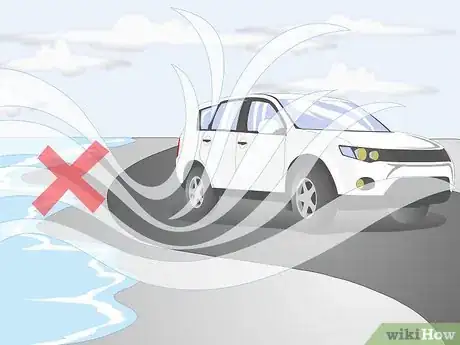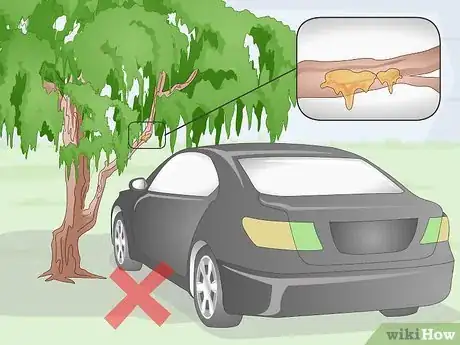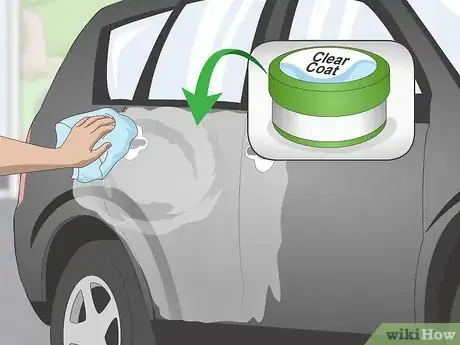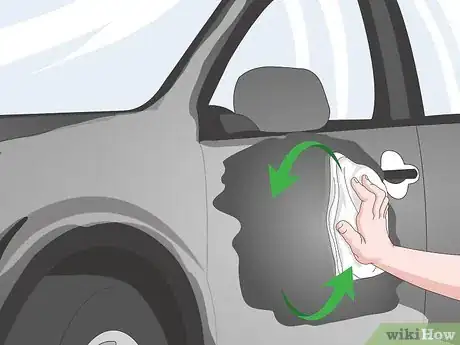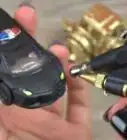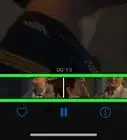This article was co-authored by Angel Ricardo. Angel Ricardo is the owner of Ricardo's Mobile Auto Detail headquartered in Venice, California. With over 10 years of experience in mobile detailing, Angel continues to attend auto detailing trainings to improve his customer service and auto detailing skills.
There are 7 references cited in this article, which can be found at the bottom of the page.
This article has been viewed 19,174 times.
Clear coat is a clear layer of paint typically painted on a vehicle to protect the colored layer of paint beneath it from UV rays, rust, and from rocks and dirt kicked up from the road. The clear coat can wear off with time, and can also be chipped off of your vehicle by salt and road debris. You can protect your clear coat primarily by washing and waxing your car.[1]
Steps
Preventing Damage
-
1Keep the car out of the sun as much as possible. Over time, the powerful UV rays in direct sunlight can wear down the clear coat on your vehicle. Hot sunlight can also open small “pores” in your car’s clear coat, allowing more dirt and debris to get in. So, to protect the clear coat and lengthen its lifespan, park your car in a garage or in shade whenever possible.[2]
- If you park your car in your driveway, consider setting up a small awning or covering to keep the sun off your car’s paint.
- You can find this type of awning at most large home-goods stores.
-
2Clear off bird droppings from your car immediately. Bird droppings are highly acidic. If they’re left on the clear coat of your car, they can erode and destroy the layer of clear coat.[3] If you spot any bird droppings on your vehicle’s paint, rinse them off immediately with water from a hose.[4]
- Better yet, avoid letting birds leave their droppings on your car in the first place. Do not park the car under trees or power lines in which birds congregate.
Advertisement -
3Protect your car’s clear coat from salty air. Salt will corrode all types of vehicle paint, including clear coat. So, if you live in a salty coastal climate, avoid driving your car on days when the wind blows the salty spray inland. Or, avoid driving your vehicle near the ocean at all, for the sake of preserving your clear coat.[5]
- If you live in a salty climate, getting salt on your car may be unavoidable. In this case, you can rinse your car off with a hose after it gets salty spray on it.
-
4Avoid getting tree sap on your vehicle. For most vehicle owners, the risk of getting tree sap on your car is much lower than the risk of encountering bird droppings or salt air. However, tree sap is a double threat: the sap can soak into your clear coat and damage it directly, or it can attract dust and dirt and force these materials into your clear coat.[6]
- So, avoid parking under or near sap-filled trees, especially if you know there are 1 or 2 branches that always seem to leak out sap.
- If your vehicle does get sap on its paint, scrub the sap off with water and a clean, dry rag.
-
5Apply a clear-coat protection product to your vehicle. Many automotive companies sell special clear-coat protection products that seal and protect your clear coat. To apply the product, simply rub it into the clear coat with a microfiber cloth. Follow the directions printed on the bottle, and apply the clear-coat protection roughly as often as you wash your vehicle. You can purchase clear-coat protection products at any large automotive-supply store [7]
- However, you should not opt for the “clear-coat protection” treatment at a car wash or dealership. It’s more effective to apply the protective coating yourself.[8]
- Or, you can take your vehicle to a professional at a vehicle detailing shop. This treatment can cost between $100 and $200 USD.
-
6Avoid taking your vehicle through an automated car wash. Automated car washes clean your car by blasting it with soapy water and scrubbing it with automated rotating brushed. However, these brushes are often abrasive and can rub dirt and dust into your vehicle’s clear coat.[9]
- Instead, use a wand-style car wash to clean your car. This will remove dirt and grime from the paint without scraping away the clear coat.
Washing the Car to Remove Dirt and Salt
-
1Wash the car every 1-4 weeks. Washing the car will remove dust and dirt that stick to the car’s clear coat over the course of driving. Dirt will quickly wear down your clear coat if left on the vehicle, so removing the dirt frequently will protect the clear coat and lengthen its lifespan. Wash the car on a rain-free day under an awning or in a shady area.[10]
- The frequency with which you wash the car depends on how often you drive it. Frequently-driven cars should washed often.
- The frequency of washing also depends upon how much you value the car. Car owners typically wash valuable classic cars more often than ordinary sedans and SUVs.
-
2Fill 2 large buckets with water. Then mix automotive wash soap into the second bucket, leaving the first full of only water. Follow the directions printed on the wash soap container, and mix the amount suggested with water from a hose or faucet.[11]
- High-quality automotive wash soap will be much better for your car’s paint than dish soap from the kitchen.
- Visit your local automotive store and look through their selection of automotive wash soaps.
-
3Wash the vehicle with a clean microfiber towel. Dip your microfiber cloth in the soapy water bucket and wipe down the painted surfaces of your vehicle. Start with the top and work your way down to the sides. When the cloth gets dirty, just dip it in the water-only bucket to rinse out the dirt. Then re-soap your cloth and continue washing the car.[12]
- Ordinary household rags may collect dirt, which will damage your clear coat. You can find microfiber cloths at an automotive supply store or a supermarket.
-
4Rinse the car with water from a hose. Once you’ve washed the full surface of the vehicle, spray it with water from your hose to remove all of the remaining soap from the paint. If your hose has a very strong spray, hold your thumb in front of the stream to weaken the blast that hits your car.[13]
- If you blast your car with the full force of a strong stream of water, it may damage the clear coat.
-
5Dry the paint with a microfiber cloth. Take 2 or 3 clean, dry microfiber cloths and rub them along the surfaces of your car remove water from the surface of the paint. Avoid letting the car sit out in the sun after you’ve finished drying it, since intense sunlight can damage the car’s paint. Once your car has dried, park it back in your garage.[14]
Waxing a Clear Coat Finish
-
1Wax your vehicle by hand every 3 months. This should be frequent enough to keep your clear coat in good shape. At a minimum, wax your vehicle 2 times a year. The best times to wax are late spring (right before summer) and late fall (just before winter). Waxing at least at these 2 points in time will protect your clear coat against the intense summer sun and salt-covered winter roads.[15]
- If you live down a dirt or gravel-covered road, you may want to wax your vehicle every 2 months. The same goes if you live in an area with frequent snowfall, since the salt put down on the roads after a snow can damage your vehicle’s clear coat.
-
2Select a wax made to cover clear coats. Some waxes are abrasive and rough and may end up doing more harm than good when you apply them to your clear coat. So, find a clear-coat friendly wax at your local automotive supply store. Look at the labels of the wax containers, and peruse until you find one that reads “clear-coat safe” on the label.[16]
- If you’re struggling to find a clear-coat safe car wax, ask the service staff at the automotive store for help.
-
3Wax your car in the shade in moderate temperatures. Plan to wax your car under a shady tree or awning when the outdoor temperature is between 50–70 °F (10–21 °C). If you try to wax your vehicle in cold weather, the wax will be sluggish and may barely move when you try to spread it on the paint. Conversely, if you wax your vehicle in hot weather, the wax may run or the heat may bake the wax into the clear coat.[17]
- If you need to watch the weather and wait a few days before waxing your car, do it. It’s better to delay waxing for a few days than to have your wax coating ruined by extreme hot or cold temperatures.
-
4Dab your wax onto a microfiber cloth. Microfiber is an excellent material for applying wax, since it won’t scratch the surface of your car.[18] Squeeze out a 1 inch (2.5 cm) dollop of wax onto your cloth. Once you’ve applied this entire amount, squeeze out another dollop of the same size. Avoid using too much wax at once, or you’ll have a hard time applying it evenly to your entire vehicle.
- It’s most effective to apply the wax shortly after you’ve washed and dried your car.
-
5Rub wax evenly across the entire painted surface of your vehicle. Work in long, vertical strokes to ensure complete coverage and prevent swirls from forming in the wax. It’s better to apply the wax too lightly than too heavily, since an overly heavy application of wax may soak into small cracks in the car. This wax is often impossible to remove.[19]
- If your first microfiber cloth gets saturated with wax, swap it out and wax with a second microfiber cloth.
-
6Buff the wax with a clean microfiber cloth until it shines. Once you’ve finished applying the wax, you’re ready to buff. This will force the wax into the clear coat and maximize the protection that the wax affords. Buff in long vertical strokes to ensure that you buff the entire painted surface of your vehicle.[20]
- Waxing your vehicle should take a total of about 1 hour.
Community Q&A
Did you know you can get expert answers for this article?
Unlock expert answers by supporting wikiHow
-
QuestionIs it a good idea to wax your car?
 Angel RicardoAngel Ricardo is the owner of Ricardo's Mobile Auto Detail headquartered in Venice, California. With over 10 years of experience in mobile detailing, Angel continues to attend auto detailing trainings to improve his customer service and auto detailing skills.
Angel RicardoAngel Ricardo is the owner of Ricardo's Mobile Auto Detail headquartered in Venice, California. With over 10 years of experience in mobile detailing, Angel continues to attend auto detailing trainings to improve his customer service and auto detailing skills.
Auto Technician
-
QuestionWhy does my paint peel when I have a clear coat?
 Angel RicardoAngel Ricardo is the owner of Ricardo's Mobile Auto Detail headquartered in Venice, California. With over 10 years of experience in mobile detailing, Angel continues to attend auto detailing trainings to improve his customer service and auto detailing skills.
Angel RicardoAngel Ricardo is the owner of Ricardo's Mobile Auto Detail headquartered in Venice, California. With over 10 years of experience in mobile detailing, Angel continues to attend auto detailing trainings to improve his customer service and auto detailing skills.
Auto Technician
Warnings
- If you don’t protect your vehicle’s clear coat, it may have so-called “clear coat failure.” This means that the layer of clear coat may start to flake or peel off of your vehicle, or may become weathered and look spotty.[24]⧼thumbs_response⧽
Things You’ll Need
- Vehicle awning (optional)
- Hose
- Clear-coat protection product
- 2 large buckets
- Automotive wash soap
- Microfiber towels
- Clear-coat car wax
References
- ↑ https://www.best-auto-detailing-tips.com/car-clear-coat.html
- ↑ Angel Ricardo. Auto Technician. Expert Interview. 1 October 2019.
- ↑ http://thecarguy.com/articles/waxtips.htm
- ↑ Angel Ricardo. Auto Technician. Expert Interview. 1 October 2019.
- ↑ http://thecarguy.com/articles/waxtips.htm
- ↑ http://thecarguy.com/articles/waxtips.htm
- ↑ Angel Ricardo. Auto Technician. Expert Interview. 1 October 2019.
- ↑ Angel Ricardo. Auto Technician. Expert Interview. 1 October 2019.
- ↑ https://jalopnik.com/heres-why-you-should-never-take-your-car-to-a-carwash-1821475097
- ↑ https://www.best-auto-detailing-tips.com/car-clear-coat.html
- ↑ https://www.detailedimage.com/Ask-a-Pro/how-to-properly-wash-and-dry-a-car/
- ↑ https://www.detailedimage.com/Ask-a-Pro/how-to-properly-wash-and-dry-a-car/
- ↑ https://www.detailedimage.com/Ask-a-Pro/how-to-properly-wash-and-dry-a-car/
- ↑ https://www.detailedimage.com/Ask-a-Pro/how-to-properly-wash-and-dry-a-car/
- ↑ https://www.angieslist.com/articles/how-often-should-i-wax-my-car.htm
- ↑ http://thecarguy.com/articles/waxtips.htm
- ↑ https://www.carsdirect.com/car-maintenance/understanding-when-you-should-wax-your-car-hot-or-cold-temperature
- ↑ https://www.angieslist.com/articles/how-often-should-i-wax-my-car.htm
- ↑ https://www.angieslist.com/articles/how-often-should-i-wax-my-car.htm
- ↑ https://www.angieslist.com/articles/how-often-should-i-wax-my-car.htm
- ↑ https://www.best-auto-detailing-tips.com/car-clear-coat.html
- ↑ https://www.best-auto-detailing-tips.com/car-clear-coat.html
- ↑ https://www.best-auto-detailing-tips.com/car-clear-coat.html
- ↑ https://www.best-auto-detailing-tips.com/car-clear-coat.html



